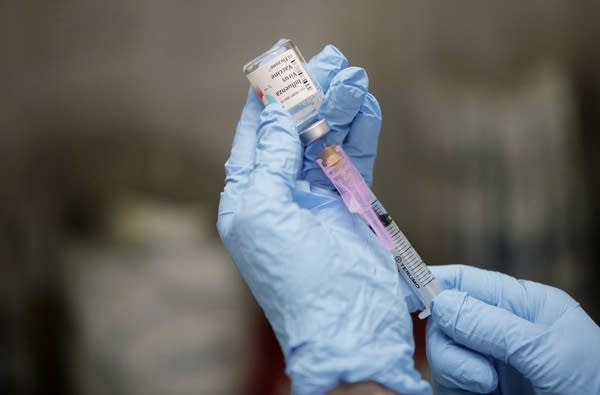Expert fears H1N1 flu vaccine will come to Minn. too late

The H1N1 flu could peak in Minnesota before enough vaccine arrives in the state, a top pandemic flu expert said Monday.
Michael Osterholm, director of the Center for Infections Diseases Research and Policy at the University of Minnesota, said he expects a surge in flu cases in the next six to eight weeks. Vaccines are expected to start arriving in Minnesota next month.
"I'm afraid too little vaccine is going to get here before the peak hits," Osterholm told about 600 people at a flu summit organized by the Minnesota Department of health.
Partly because of that timeline, State Epidemiologist Ruth Lynfield and other speakers stressed the need for people to be conscious about not spreading illness.
Create a More Connected Minnesota
MPR News is your trusted resource for the news you need. With your support, MPR News brings accessible, courageous journalism and authentic conversation to everyone - free of paywalls and barriers. Your gift makes a difference.
Echoing Osterholm, she said that means sick people shouldn't try to be "Minnesota brave" and go to work or school. She also urged diligent hand washing, covering one's mouth when coughing and keeping one's distance from sick people.
As of Monday morning, Minnesota had recorded 265 H1N1 flu cases severe enough to require hospitalization, including three deaths, Lynfield said. The state is no longer keeping count of cases that don't require hospitalization.
Eighty percent of the hospitalized cases were in the seven-county Twin Cities metro area, though Lynfield said infections in greater Minnesota are on the rise. Two-thirds of those hospitalized had an underlying risk factor, such as asthma or pregnancy. The median age was 12, and 70 percent of those hospitalized were under 25 years old.
Lynfield said Minnesota health officials have been expecting vaccines to be available here in late October.
[image]
U.S. Health and Human Services Secretary Kathleen Sebelius said Sunday that some may be available as early as the first week of October for health care workers and other high-priority groups, but that an ample supply won't be ready before mid-October.
Speakers at the conference tried to dispel the idea that this kind of flu is relatively mild. Lynfield said the severity is similar to regular seasonal flu, but the victims tend to be younger.
However, Lynfield said most people who contract the virus probably won't need medical attention.
"If there is someone who does not have severe symptoms ... they're not in a high-risk group, they need to stay home," she said. "There is no particular reason why they need to go into the emergency room or go into their doctor's office."
Kathy Rausch,a nurse at Marathon Petroleum, told Health Department officials that her employer has already given all of its workers anti-viral medications to take if they show flu symptoms.
Health officials discouraged the strategy saying it could promote drug resistance. Afterward Rausch said she understands the risks, but she needs to keep her refinery open.
"If my people aren't there, if we get as they advertised, a 35 percent absenteeism, I'm going to have to close my refinery," Rausch said. "That means that every Speedway gas station, every Marathon gas station and every Super America gas station in the city is going to close down because that's where they get their gas, from me."
Underlying conditions that put people at greater risk for getting it include asthma and other respiratory conditions, obesity, pregnancy, diabetes and cardiovascular and neurological problems, she said. Obesity, in particular, is turning out to be a bigger risk factor than first expected, she said.
Sanne Magnan, commissioner of the Minnesota Department of Health, urged the health professionals and others at the conference to be vigilant and do everything they can to limit the spread.
"It's going to take lots of interventions, lots of approaches and lots of roles to play to chase H1N1 out of town," she said.
